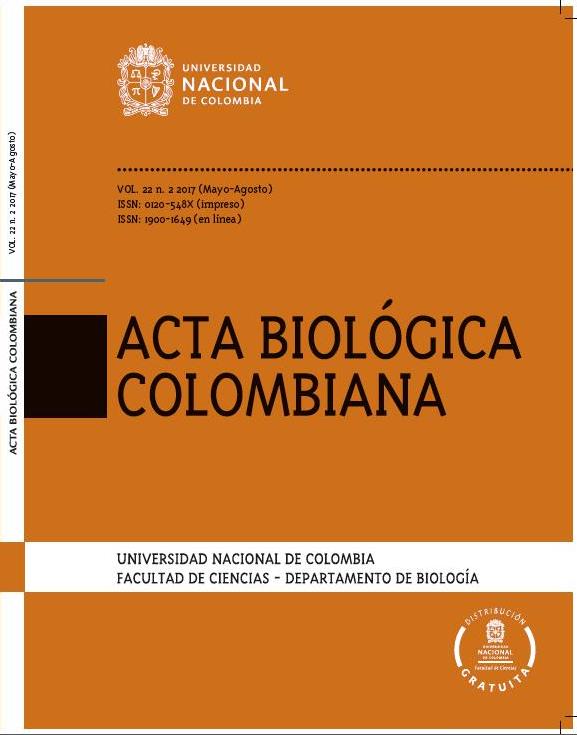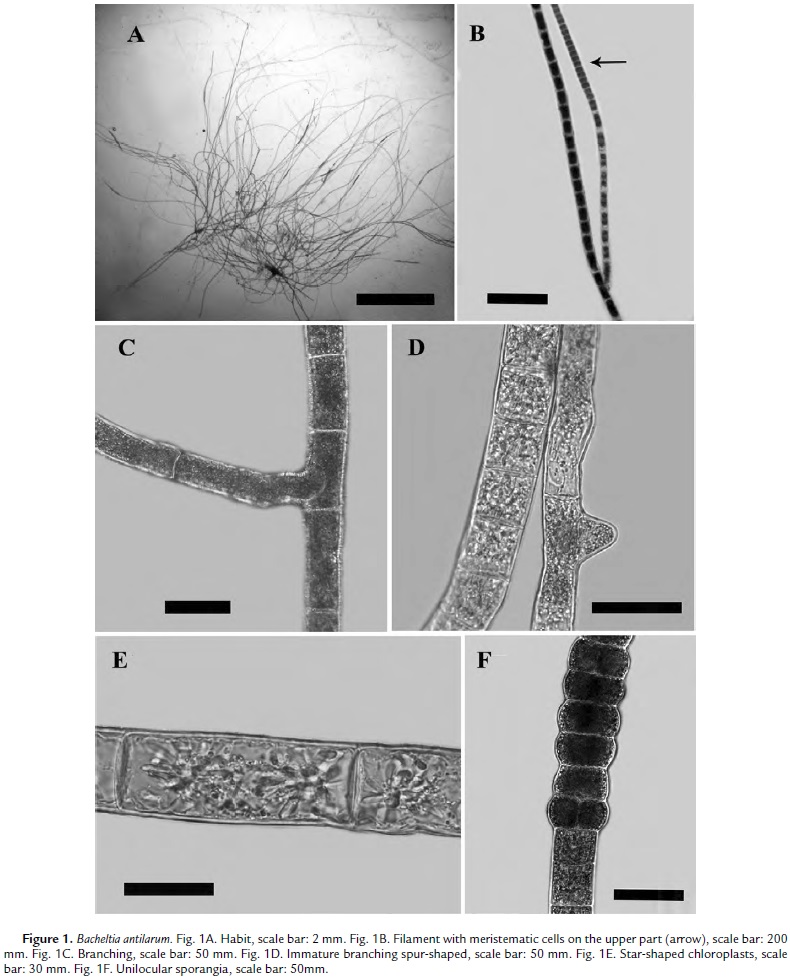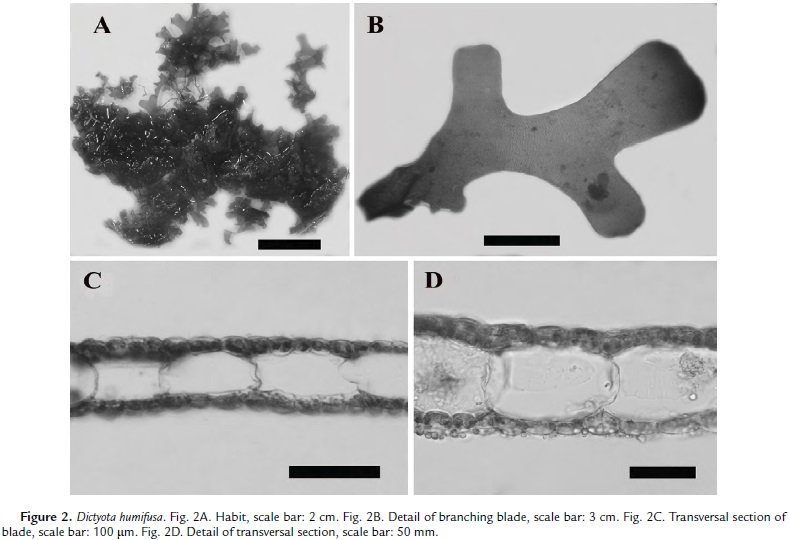Notes on the marine algae of the International Biosphere Reserve Seaflower, Caribbean Colombia VI: New records of Phaeophyceae from Old Providence and Santa Catalina.
Notas sobre las algas marinas de la Reserva Internacional de Biosfera Seaflower, Caribe colombiano VI: nuevos registros de algas pardas (Phaeophyceae)
DOI:
https://doi.org/10.15446/abc.v22n2.60363Palabras clave:
Bachelotia, brown algae, Dictyota, new records, Seaflower (en)algas pardas, Bachelotia, Dictyota, nuevos registros, Seaflower (es)
Descargas
Dos nuevos registros de algas pardas (Phaoephyceae), Bachelotia antillarum y Dictyota humifusa son registradas por primera vez para el Archipiélago de San Andrés, Providencia y Santa Catalina, Reserva Internacional de la Biosfera Seaflower.
DOI: https://doi.org/10.15446/abc.v22n2.60363
NOTES ON THE MARINE ALGAE OF THE INTERNATIONAL BIOSPHERE RESERVE SEAFLOWER, CARIBBEAN COLOMBIA VI: NEW RECORDS OF BROWN ALGAE (PHAEOPHYCEAE)
Notas sobre las algas marinas de la Reserva Internacional de Biosfera Seaflower, Caribe colombiano VI: nuevos registros de algas pardas (Phaeophyceae)
Viviana Patricia REYES-GÓMEZ1,2, Brigitte GAVIO1.
1 Laboratorio de Biología Marina, Departamento de Biología, edificio 421, Universidad Nacional de Colombia, Sede Bogotá, Carrera 30 Calle 45, Ciudad Universitaria. Bogotá, Colombia.
2 Laboratorio de Ficología y Sección de algas del Herbario de la Facultad de Ciencias, Universidad Nacional Autónoma de México, 03510, Ciudad de México, México.
For correspondence. bgavio@unal.edu.co
Received: 3rd October 2016, Returned for revision: 14th December 2016, Accepted: 23rd March 2017.
Associate Editor: John Charles Donato Rondón.
Citation/Citar este artículo como: Reyes-Gómez VP, Gavio B. Notes on the marine algae of the International Biosphere Reserve Seaflower, Caribbean Colombia VI: New records of brown algae (Phaeophyceae). Acta biol. Colomb. 2017;22(2):238-241. DOI: https://doi.org/10.15446/abc.v22n2.60363
ABSTRACT
Two species ofbrown algae (Phaeophyceae), Bachelotia antillarum and Dictyota humifusa are reported for the first time for the Archipelago of San Andrés, Providencia and Santa Catalina, part of the International Biosphere Reserve Seaflower.
Keywords: Bachelotia, brown algae, Dictyota, new records, Seaflower.
RESUMEN
Dos nuevos registros de algas pardas (Phaoephyceae), Bachelotia antillarum y Dictyota humifusa son registradas por primera vez para el Archipiélago de San Andrés, Providencia y Santa Catalina, Reserva Internacional de la Biosfera Seaflower.
Palabras clave: algas pardas, Bachelotia, Dictyota, nuevos registros, Seaflower.
Benthic marine algae of the Archipelago of San Andres, Old Providence and Sainte Cataline, Colombia, have been poorly documented to date, primarily due to a paucity of floristic studies in the area. In 2003, Díaz-Pulido and Díaz-Ruiz listed a total of 201 species of marine algae, well below the number of species of other regions of Colombia. Recent works on the marine flora of the Archipelago (Albis-Salas and Gavio 2011; Ortiz and Gavio 2012; Gavio et al., 2013; Reyes-Gómez et al., 2013; Rincón-Díaz et al., 2014; Albis-Salas and Gavio, 2015; Gavio and Mancera-Pineda, 2015; Gavio et al., 2015; Barrera et al., 2016) have reported a diversity never registered before, increasing the number of seaweeds for the Archipelago to 298 taxa. During a collecting trip to Providencia and Santa Catalina Islands in 2009, we observed two species of brown algae, which have not been reported for the Archipelago before: Bachelotia antillarum (Grunow) Gerloff 1959 and Dictyota humifusa Hörnig, Schnetter et Coppejans 1992.
The species Bachelotia antillarum (Family Bachelotiaceae) (Fig. 1) has a filamentous thallus, dark brown. Uniseriate filaments are epiphytic on larger algae, attached by a prostrate filament (Fig. 1A). Vegetative cells are rectangular, longer than wide, 40-45 μm diam and 100-110 μm long. Meristematic cells are darker in color and shorter than somatic cells (Fig. 1B). Branching is scarse and distributed along the filament (Figs. 1C-1D). Chloroplasts are star-shaped, in pairs (Fig. 1E). Sporangia are unilocular, intercalary in the vegetative filament inside meristematic region of the thallus, 50 um diam and 20-25 μm long (Fig. 1F). The specimen was observed entangled with Ulva flexuosa Wulfen in Santa Catalina Island, intertidal on the beach before Morgan's Head.
Bachelotia antillarum was collected nearshore among mangrove tree roots, and formed a green-brownish patch among the roots. According to Díez et al. (2009) and Figueroa and Korbee (2010) algae with simple morphology are common in polluted places, and B. antillarum is a species that can be observed in extremely degraded systems. We consider that this is not the case for Santa Catalina Island, but it would be interesting to monitor the water quality of the area as well as any change in the algal community.
Dictyota humifusa (Family Dictyotaceae) (Fig. 2) has a flattened, band-shaped thallus, with a prostrate habit, light green in color, and blue iridescence under water (Fig. 2A). Branching is irregular to dichotomous (Fig. 2B). Blades are 85-95 μm thick. Medulla is unistratified, composed of rectangular to rounded cells, 60-65 μm diam and 100-110 μm long. Cortical cells rectangular, 15-25 μm long and 1012,5 μm diam (Figs. 2C-2D). This specimen was observed in Providencia Island, at Bajo San Felipe, at depths of 8-13 m.
Many species of Dictyota produce terpens that inhibit herbivory (Schmitt et al., 1998; Pereira et al., 2000). Stirk et al. (2007) showed that the species D. humifusa has secondary metabolites, which have antibacterial and antimycotic properties. In the study, D. humifusa was the only species to be able to hinder Escherichia coli growth. Furthermore, its extracts have inhibitory activity for Acetylcholinesterase (AChE), an enzyme which interferes with Acetylcholine, neurotransmitter involved in neurological disorders. Incrementing concentrations of Acetylcholine through inhibition ofAChE, is considered the most efficient treatment against Alzheimer disease. For this reason, D. humifusa may be of interest for pharmaceutical bioprospection (Stirk et al., 2007).
ACKNOWLEDGEMENTS
We wish to thank the divers of Felipe's diving, in Providencia, Juan Felipe Ortiz and Hernan Velasquez for field assistance. This project was funded by Universidad Nacional de Colombia, Sede Caribe, through the projects # 20101003400, # 20501003060 and # 20101004460.
CONFLICT OF INTEREST
The authors declare that they have no conflict of interest.
REFERENCES
Albis-Salas M, Gavio B. Notes on the marine algae of the International Biosphere Reserve Seaflower, Caribbean Colombian I: New records of macroalgal epiphytes on the seagrass Thalassia testudinum. Bot Mar. 2011;54:537-543.
Albis-Salas M, Gavio B. Notes on the marine algae of the International Biosphere Reserve Seaflower, Caribbean Colombia IV: New records of macroalgal epiphytes on the seagrass Thalassia testudinum. Bolt Invest Mar Cost. 2015;44(1):55-70.
Barrera JC, Gavio B, Mancera JE. Macroalgas asociadas al hábitat del gasterópodo Cittarium pica (Linneaus, 1758), en la isla de San Andrés, Colombia. In: Campos N.H., Acero P. A., editors. Contribuciones en Ciencias del Mar de la Universidad Nacional de Colombia. CECIMAR, Sede Caribe, Universidad Nacional de Colombia, Santa Marta. 2016. p. 15-27.
Díaz-Pulido G, Díaz-Ruíz M. Diversity of benthic marine algae of the Colombian Atlantic. Biota Colombiana. 2003;4:203-246.
Díez I, Santolaria A, Secilla A, Gorostiaga JM. Recovery stages over long-term monitoring of the intertidal vegetation in the 'Abra de Bilbao' area and on the adjacent coast (N. Spain). Eur J Phycol. 2009;44(1):1-14.
Figueroa FL, Korbee N. Interactive effects of UV radiation and nutrients on ecophysiology: vulnerability and adaptation to climate change. In: Israel A, Einvav R, Seckbach J., editors. Seaweeds and Their Role in Globally Changing Environments. Springer, New York; 2010. p. 161-163.
Gavio B, Mancera-Pineda JE. Blooms of ephemeral green algae in San Andres Island, International Biosphere Reserve Seaflower, Southwestern Caribbean. Acta biol Colomb. 2015;20(2):259-262.
Gavio B, Reyes-Gómez VP, Wynne MJ. Crouania pumila sp. nov. (Callithamniaceae: Rhodophyta), a new species of marine red algae from the Seaflower International Biosphere Reserve, Caribbean Colombia. Rev Biol Trop. 2013;61:1015-1023.
Gavio B, Cifuentes-Osa MA, Wynne MJ. Notes on the Marine Algae of the International Biosphere Reserve Seaflower, Caribbean Colombia V: first study of the algal flora of Quitasueño Bank. Bolt Invest Mar Cost. 2015;44(1):117-126.
Gerloff, J. Bachelotia (Bornet) Kuckuck ex Hamel oder Bachelotia (Bornet) Fox?. Nova Hedwigia. 1959,1:37-39.
Hörnig I, Schnetter R, Prud'homme van Reine W.F, Coppejans E, Achenbach-Wege K, Over J.M. The genus Dictyota (Phaeophyceae) in the North Atlantic. I. A new generic concept and new species. Nova Hedwigia. 1992;54:45-62.
Ortiz JF, Gavio B. Notes on the marine algae of the International Biosphere Reserve Seaflower. II: diversity of drift algae in San Andrés Island, Caribbean Colombia. Caribb J Sci. 2012;46:313-321.
Pereira RC, Cavalcanti DN, Teixeira VL. Effects of secondary metabolites from the tropical Brazilian brown alga Dictyota menstrualis on the amphipod Parhyale hawaiensis. Mar Ecol Progr Ser. 2000;205:95-100.
Reyes-Gómez V, Gavio B, Velasquez H. Notes on the marine algae of the international biosphere reserve Seaflower, Caribbean Colombia III. New records of Cyanophyta. Nova Hedwig. 2013;97(3-4):349-360.
Rincón-Díaz N, Gavio B, Santos-Martínez A. Occurrence of tetrasporangia in Ceramium bisporum (Ceramiales: Rhodophyta). Acta biol Colomb. 2014;19(2):315-318.
Schmitt TM, Lindquist N, Hay ME. Seaweed secondary metabolites as antifoulants: effects if Dictyota spp. diterpenes on survivorship, settlement, and development of marine invertebrate larvae. Chemoecology. 1998;8:125-131.
Stirk W, Reinecke D, Staden J.V. Seasonal variation in antifungal, antibacterial and acetylcholinesterase activity in seven South African seaweeds. J Appl Phycol. 2007;19:271-276.
Referencias
Albis-Salas M, Gavio B. Notes on the marine algae of the International Biosphere Reserve Seaflower, Caribbean Colombian I: New records of macroalgal epiphytes on the seagrass Thalassia testudinum. Bot Marina, 2011;54:537–543.
Albis-Salas M, Gavio B. Notes on the marine algae of the International Biosphere Reserve Seaflower, Caribbean Colombia IV: New records of macroalgal epiphytes on the seagrass Thalassia testudinum. Boletín de Investigaciones Marinas y Costeras, 2015;44(1):55-70.
Barrera JC, Gavio B, Mancera JE. Macroalgas asociadas al hábitat del gasterópodo Cittarium pica (Linneaus, 1758), en la isla de San Andrés, Colombia. In: Campos, N. H. y A. Acero P. (eds.). Contribuciones en Ciencias del Mar de la Universidad Nacional de Colombia. CECIMAR, Sede Caribe, Universidad Nacional de Colombia, Santa Marta. 2015. p. 15-27.
Bula-Meyer G. Notas sobre Dictyota pfaffii y D. humifusa (Dictyotales, Phaeophyta). Anales Inst Invest Mar Punta de Betín. 1994;23:177-181.
Díez I, Santolaria A, Secilla A, Gorostiaga JM. Recovery stages over long-term monitoring of the intertidal vegetation in the ‘Abra de Bilbao’ area and on the adjacent coast (N. Spain). Eur J Phycol. 2009;44(1):1–14.
Díaz JM, Barrios LM, Gómez-López DI. Las praderas de pastos marinos en Colombia: Estructura y distribución de un ecosistema estratégico. INVEMAR, Serie Publicaciones Especiales, Santa Marta. 2003;10:39-40,
Díaz-Pulido G, Díaz-Ruíz M. Diversity of benthic marine algae of the Colombian Atlantic. Biota Colombiana. 2003;4:203–246.
Figueroa FL, Korbee N. Interactive effects of UV radiation and nutrients on ecophysiology: vulnerability and adaptation to climate change. In: Israel, A., Einvav, R., Seckbach, J. (Eds.), Seaweeds and Their Role in Globally Changing Environments. Springer, New York; 2010. p.161-163.
Gavio B, Mancera-Pineda JE. Blooms of ephemeral green algae in San Andres Island, International Biosphere Reserve Seaflower, Southwestern Caribbean. Acta Biologica Colombiana 2015;20(2):259-262.
Gavio B, Reyes-Gómez VP, Wynne MJ. Crouania pumila sp. nov. (Callithamniaceae: Rhodophyta), a new species of marine red algae from the Seaflower International Biosphere Reserve, Caribbean Colombia. Revista de Biología Tropical 2013;61:1015-1023.
Gavio B, Cifuentes-Osa MA, Wynne MJ. Notes on the Marine Algae of the International Biosphere Reserve Seaflower, Caribbean Colombia V: first study of the algal flora of Quitasueño Bank. Bolt Invest Mar Cost. 2015;44 (1): 117-126.
Hörnig I, Schnetter R, Prud'homme van Reine WF, Coppejans E, Achenbach-Wege K, Over JM. The genus Dictyota (Phaeophyceae) in the North Atlantic. I. A new generic concept and new species. Nova Hedwigia. 1992;54:45-62.
Littler DS, Littler MM. Caribbean reef plants. OffShore Graphics, Washington D.C., USA; 2000. p. 542.
Magne F. Quelques caractères cytologiques du Bachelotia antillarum (Phéophycées, Ectocarpales). Phycologia. 1976;15:309–319.
Ortiz JF, Gavio B. Notes on the marine algae of the International Biosphere Reserve Seaflower. II: diversity of drift algae in San Andrés Island, Caribbean Colombia. Caribbean J Sci. 2012;46:313–321.
Pereira RC, Cavalcanti DN, Teixeira VL. Effects of secondary metabolites from the tropical Brazilian brown alga Dictyota menstrualis on the amphipod Parhyale hawaiensis. Mar Ecol Progr Ser. 2000;205:95–100.
Peters AF, Clayton MN. Molecular and morphological investigations of three brown algae genera with stellate plastids: evidence for Scytothamnales ord. nov. (Phaeophyceae). Phycologia. 1998;37:106–113.
Reyes-Gómez V, Gavio B, Velasquez H. Notes on the marine algae of the international biosphere reserve Seaflower, Caribbean Colombia III. New records of Cyanophyta. Nova Hedwigia 2013;97(3–4):349–360.
Rincón-Díaz N, Gavio B, Santos-Martínez A. Occurrence of tetrasporangia in Ceramium bisporum (Ceramiales: Rhodophyta). Acta Biologica Colombiana. 2014;19(2): 315-318
Schnetter R. Nuevas algas bénthicas del littoral Caribe de Colombia. Mutisia. 1972;36:12-16.
Schmitt TM, Lindquist N, Hay ME. Seaweed secondary metabolites as antifoulants: effects if Dictyota spp. diterpenes on survivorship, settlement, and development of marine invertebrate larvae. Chemoecology. 1998;8:125–31.
Silberfeld T, Racault MFLP, Fletcher RL, Couloux A, Rousseau F, DeReviers B. Systematics and evolutionary history of pyrenoid-bearing taxa in brown algae (Phaeophyceae).European Journal of Phycology 2011;46:(4)361-377.
Silberfeld T, Rousseau F, Reviers B. An updated classification of brown algae (Ochrophyta, Phaeophyceae).Cryptogamie Algologie 2014;35(2):117-156.
Stirk W, Reinecke D, Staden J.V. Seasonal variation in antifungal, antibacterial and acetylcholinesterase activity in seven South African seaweeds. J Appl Phycol. 2007;19:271–276
Cómo citar
APA
ACM
ACS
ABNT
Chicago
Harvard
IEEE
MLA
Turabian
Vancouver
Descargar cita
CrossRef Cited-by
1. Y. Carla M. Daza, Víctor Díaz, Paola Andrea Franco, Brigitte Gavio. (2025). Notes on the Marine Algae of the International Biosphere Reserve Seaflower, Caribbean Colombia X: New Records of Red Algae (Rhodophyta) from Old Providence and Santa Catalina. Thalassas: An International Journal of Marine Sciences, 41(1) https://doi.org/10.1007/s41208-024-00783-2.
2. Viviana Patricia Reyes-Gómez, Hernán Velásquez Pomar, Brigitte Gavio. (2021). Notas sobre las algas marinas de la Reserva Internacional de la Biosfera Seaflower, Caribe Colombiano VIII: nuevos registros de algas rojas (Rhodophyta) de San Andrés, Providencia y Santa Catalina, Colombia. Acta Botanica Mexicana, (128) https://doi.org/10.21829/abm128.2021.1848.
3. Fernando Cárdenas-Barón, Brigitte Gavio, Michael J. Wynne. (2025). Notes on the marine algae of the International Biosphere Reserve Seaflower, Caribbean Colombia XI: Pseudobryopsis basiglabra sp. nov. (Pseudobryopsidaceae, Chlorophyta). Acta Botanica Mexicana, (132) https://doi.org/10.21829/abm132.2025.2419.
Dimensions
PlumX
Visitas a la página del resumen del artículo
Descargas
Licencia
Derechos de autor 2017 Acta Biológica Colombiana

Esta obra está bajo una licencia internacional Creative Commons Atribución 4.0.
1. La aceptación de manuscritos por parte de la revista implicará, además de su edición electrónica de acceso abierto bajo licencia Attribution-NonCommercial-ShareAlike 4.0 (CC BY NC SA), la inclusión y difusión del texto completo a través del repositorio institucional de la Universidad Nacional de Colombia y en todas aquellas bases de datos especializadas que el editor considere adecuadas para su indización con miras a incrementar la visibilidad de la revista.
2. Acta Biológica Colombiana permite a los autores archivar, descargar y compartir, la versión final publicada, así como las versiones pre-print y post-print incluyendo un encabezado con la referencia bibliográfica del articulo publicado.
3. Los autores/as podrán adoptar otros acuerdos de licencia no exclusiva de distribución de la versión de la obra publicada (p. ej.: depositarla en un archivo telemático institucional o publicarla en un volumen monográfico) siempre que se indique la publicación inicial en esta revista.
4. Se permite y recomienda a los autores/as difundir su obra a través de Internet (p. ej.: en archivos institucionales, en su página web o en redes sociales cientificas como Academia, Researchgate; Mendelay) lo cual puede producir intercambios interesantes y aumentar las citas de la obra publicada. (Véase El efecto del acceso abierto).























